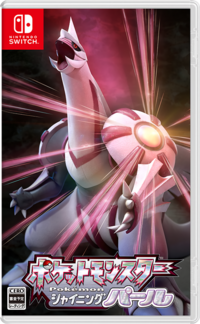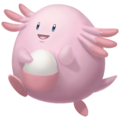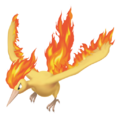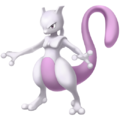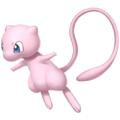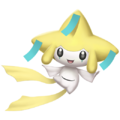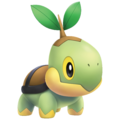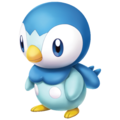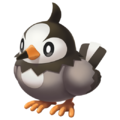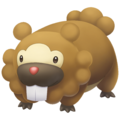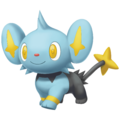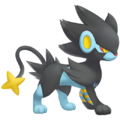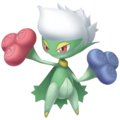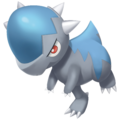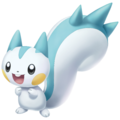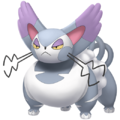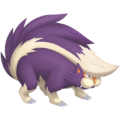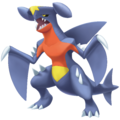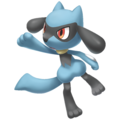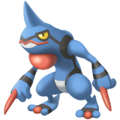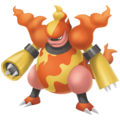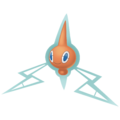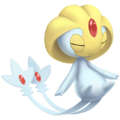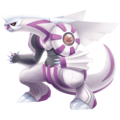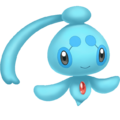Pokémon Brilliant Diamond and Shining Pearl
| Pokémon Brilliant Diamond ポケットモンスター ブリリアントダイヤモンド | |
|---|---|
 Pokémon Brilliant Diamond's boxart, featuring Dialga | |
| Pokémon Shining Pearl ポケットモンスター シャイニングパール | |
 Pokémon Shining Pearl's boxart, featuring Palkia | |
Basic info
| |
| Platform: | Nintendo Switch |
| Category: | RPG |
| Players: | 1-2, 4 players simultaneous |
| Connectivity: | Wireless, Nintendo Switch Online |
| Developer: | ILCA, Inc. |
| Publisher: | Nintendo/The Pokémon Company |
| Part of: | Generation VIII core series |
Ratings
| |
| CERO: | A |
| ESRB: | E |
| ACB: | PG |
| OFLC: | PG |
| PEGI: | 7 |
| GRAC: | ALL |
| GSRR: | 6+ |
Release dates
| |
| Japan: | November 19, 2021 |
| North America: | November 19, 2021 |
| Australia: | November 19, 2021 |
| Europe: | November 19, 2021 |
| South Korea: | November 19, 2021 |
| Hong Kong: | November 19, 2021 |
| Taiwan: | November 19, 2021 |
Websites
| |
| Japanese: | Pokémon.co.jp |
| English: | Official site Pokémon.com Nintendo.com (Brilliant Diamond) Nintendo.com (Shining Pearl) |
|
Japanese boxart
| |
Pokémon Brilliant Diamond (Japanese: ポケットモンスター ブリリアントダイヤモンド Pocket Monsters Brilliant Diamond) and Pokémon Shining Pearl (Japanese: ポケットモンスター シャイニングパール Pocket Monsters Shining Pearl) are the second paired Generation VIII games that are enhanced remakes of the fourth-generation titles Pokémon Diamond and Pearl.
The games were announced worldwide on the 25th Anniversary of the release of Pokémon Red and Green on February 27, 2021 at 12 am JST through Pokémon Presents. The paired versions were released worldwide for Nintendo Switch on November 19, 2021. All copies of the game are playable in nine languages: Japanese, English, German, Spanish, French, Italian, Korean, and Simplified and Traditional Chinese. These are the first core series games not to be developed directly by Game Freak.
Features
Overall, the game's graphical style is different compared to Pokémon Sword and Shield. The camera returns to a mostly top-down viewing angle similar to the original Diamond and Pearl, while the player and NPCs appear with chibi proportions in the overworld but regular proportions in battle. The regular overworld uses random encounters only, while Pokémon Hideaways in the Grand Underground use symbol encounters.
Like in the originals, the games only include Pokémon from the first four generations; therefore, the games include a total of 493 Pokémon.
New features
- The Underground has been replaced with the Grand Underground.
- Pal Park has been replaced with Ramanas Park.
- The Global Trade Station (GTS) has been replaced with the Global Wonder Station (GWS).
- Amity Square now supports up to six walking Pokémon instead of just one. It retains the limitation that only "cute" Pokémon may walk, although as in Platinum, the starters and their evolutions are included, and now Eevee and its evolutions are supported as well.
- The player may also pose for screenshots and save them to the Nintendo Switch's Album.
- The Poffin-making minigame can now be performed inside Amity Square. The player's walking Pokémon surround the bowl during the minigame, visibly reacting to the player's cooking.
- With the Nintendo Switch's lack of a bottom screen, the Pokétch may now be either absent from the screen, present in the top right corner of the screen, or enlarged to take up the majority of the screen (during which the regular overworld in the background has a blur filter applied). These three different methods of viewing are switched between using the R button. The touch screen or a pointer cursor can be used to control the Pokétch while it uses the enlarged screen.
- HMs have been removed; instead, the Pokétch has a new "Hidden Moves" app allowing the player to call wild Pokémon to perform field moves corresponding to the original game's HMs. These wild Pokémon are the same regardless of location: Bidoof for Rock Smash and Cut, Staraptor for Fly and Defog, and Bibarel for Strength, Rock Climb, Surf, and Waterfall.
- Hidden Moves now skip the splash screen animation when used multiple times in the same area.
- It is implied that at least some touch features of the Pokétch are available even when not enlarged, as an off-center Dowsing Machine circle can be seen in one screenshot.
- HMs have been removed; instead, the Pokétch has a new "Hidden Moves" app allowing the player to call wild Pokémon to perform field moves corresponding to the original game's HMs. These wild Pokémon are the same regardless of location: Bidoof for Rock Smash and Cut, Staraptor for Fly and Defog, and Bibarel for Strength, Rock Climb, Surf, and Waterfall.
- The Town Map now has new features allowing it to show the locations of Honey Trees (distinguishing between Honey Trees with no Honey, Honey Trees with Honey but no wild Pokémon, and Honey Trees with wild Pokémon) and Berries that can be picked.
- Due to this, the Pokétch's Berry Searcher app has been removed, as it would be redundant.
- The miniature sprites used for all Pokémon between Generation III and Sword and Shield now have a different appearance, no longer looking pixelated.
- The icons that represent types have undergone numerous changes. For example, the plain circle icon for the Normal type now depicts two nubs resembling Bidoof's ears.
- Pokémon now have different cries when they faint.
- If the Nintendo Switch system being used has save data from previous mainline Pokémon games, the player may talk to an NPC in Floaroma Town to receive a Mythical Pokémon:
- Jirachi, if Sword and Shield save data exists.
- Mew, if Let's Go, Pikachu! and Let's Go, Eevee! save data exists.
- A new Key Item has been added: the DS Sounds. It is very similar to the GB Sounds from Pokémon HeartGold and SoulSilver, and can be used to replace the music in the game with the original versions of the songs from Diamond and Pearl. It is obtained from the Sound Designer, a guitarist who appears in Game Freak's house on Valor Lakefront after the player enters the Hall of Fame.
Features from Pokémon Platinum
- Rotom can change forms in Rotom's Room. The Secret Key is no longer event-exclusive, and is obtained after catching Rotom in the Old Chateau.
- Like in Generation V onward, Rotom's forms have different types.
- Giratina's Origin Forme is included. The Griseous Orb is now obtained from the Distortion Room in Ramanas Park after defeating Origin Forme Giratina in battle.
- As Giratina can only be caught in Turnback Cave, the Origin Forme Giratina is shown in a shadow-based form when fought to signify it cannot be caught.
- Shaymin's Sky Forme is included. The NPC in Floaroma Town who gives the Gracidea in Platinum is present.
- As in every game since Platinum, entering the Hall of Fame causes in-game event Pokémon who have been defeated to reappear, so they are not permanently missable.
Features from recent generations
- The Fairy type has been added. The Roseli Berry and Pixie Plate have also been added to accommodate for this.
- The Steel type no longer resists Ghost and Dark.
- The player may have one walking Pokémon anywhere in the overworld outside of Amity Square. The feature is unlocked after visiting Amity Square once, and can be used with Pokémon outside of those that could walk in the original Amity Square.
- As in Let's Go, Pikachu! and Let's Go, Eevee!, different Pokémon walk at different speeds, and the player may directly interact with their walking Pokémon.
- At the beginning of the game, the player can choose from eight different appearances (four for Lucas and four for Dawn), which feature different skin tones and hair colors.
- Trainer customization is now available. The Metronome Style Shop, where outfits can be purchased, replaces the location of what used to be the Veilstone Game Corner, while the prize exchange house has been replaced with a functionally useless storage building.
- An early-purchase bonus event gives the player character an outfit based on their design in Pokémon Platinum.
- The inclusion of the Apricorn Poké Balls, recently reintroduced in Generation VIII through Pokémon Sword and Shield's first expansion, The Isle of Armor.
- The Autosave option returns from Sword and Shield.
- The Exp. Share functions how it has since Let's Go, Pikachu! and Let's Go, Eevee!. Rather than an item, Exp. Share is a background mechanic that applies to the player's party from the start of the game and cannot be turned off.
- Two battle screen features present since Pokémon Sun and Moon continue to appear:
- Type effectiveness is shown in the move selection screen.
- The player can press the Y button to bring up a Bag sub-menu for Poké Balls in wild battles.
- The Pokémon Box Link returns (albeit no longer as an item), allowing the Pokémon Storage System to be accessed from anywhere. Like in Sword and Shield, it is obtained a short way into the game.
- The Pokémon Nursery replaces the Pokémon Day Care.
- Origin marks return. A new origin mark that corresponds to these games has been added.
- Like in Sword and Shield, affection has been merged with friendship, meaning that friendship now results in affection bonuses.
- Critical captures return.
- The Catching Charm returns from Sword and Shield. It is given out by one of the Game Directors on Valor Lakefront after reaching the criteria for obtaining the Regional Pokédex diploma.
- Morimoto is now present on Route 213 as a swimmer, being available to battle once per day after the Hall of Fame has been entered. After the first time he is defeated, he rewards the player with an Oval Charm.
- Hyper Training, Bottle Caps and Gold Bottle Caps return. A veteran in the Battle Park's Exchange Service Corner can Hyper Train the player's Level 100 Pokémon in exchange for Bottle Caps and Gold Bottle Caps.
- The Rotom Catalog returns from Sword and Shield. It is obtained after Rotom first enters one of the appliances in Rotom's Room, though at first it only contains Rotom's normal form and the appliance that it entered to obtain the catalog. The other appliances can then be taken from Rotom's Room to add them to the catalog.
- The Shiny Charm returns, albeit only increasing the chance of an Egg containing a Shiny Pokémon.
Returning features
- Seals return for the first time since HeartGold and SoulSilver, and are now called Stickers.
- The player may now earn Stickers from completing Super Contest Shows or by defeating Gym Leaders.
- There are now "over 90" different Stickers in the game, up from 77. "Ribbon Sticker C" and "Ribbon Sticker D" have been seen in screenshots as new Stickers.
- Up to 20 Stickers may be placed on a Ball Capsule, up from 8.
- The menu for positioning Stickers on a Ball Capsule now supports 3D movement for more detailed placement.
- The boy in the easternmost house of Solaceon Town no longer awards letter Stickers for showing him the different forms of Unown, instead awarding extra Ball Capsules.
- Pokémon Super Contests return for the first time since Platinum, and are renamed Super Contest Shows.
- Ball Capsules and Stickers are now used during the Visual round in place of Accessories.
- The points earned during the rounds are now named Hype Points.
- An unspecified mechanic appears to involve adding up the Hype Points of all four competitors and comparing it to a target score.
- Contests now support online connectivity.
- The Union Room returns for the first time since Generation V.
- There are now two rooms, called the "Local Room" and "Global Room", the latter of which newly supports online connections.
- The Manaphy Egg is obtainable through an event for the first time since Generation IV. It is now an early-purchase bonus event.
- TMs are single-use again, which was the case for all Pokémon games before Generation V.
- Unlike in Diamond and Pearl, however, TMs have repeatable acquisition methods. Most NPCs who give TMs now give three of the same TM, while Gym Leaders give five of the reward TM with the badge. All TMs can also be bought in the Grand Underground by trading Spheres.
- The National Pokédex returns in a core series game for the first time since Pokémon Omega Ruby and Alpha Sapphire (though it only features the first 493 Pokémon, as in the original Diamond and Pearl).
- The Berry growing mechanic returns.
- Honey Trees return for the first time since Platinum.
- Footprints are displayed in the Pokédex for the first time since Pokémon Black 2 and White 2.
- The Badge-polishing feature returns. The Badge case can be viewed from the Trainer Card.
- The Key Items Vs. Seeker and Poké Radar both return.
- The Moss Rock, Ice Rock, and special magnetic field have returned following their removal in Sword and Shield. As in Sword and Shield, most of the Pokémon that evolve using these methods can still evolve using Evolution stones instead, although the Ice Stone is not obtainable, and Nosepass was not given a second evolution method.
- Several moves that were unusable in Sword and Shield have returned: Flash, Sketch, Hidden Power, Tail Glow, Psycho Boost, Heart Swap, Rock Climb, Chatter, Judgment, Dark Void, Seed Flare, and Toxic Thread. More information can be found here.
Connectivity
The game is planned to receive Pokémon HOME connectivity at some point in 2022. The game does not support Ranked Battles.
Game-exclusive Pokémon
The following Pokémon are only obtainable in one game of this pair.[1] In order to obtain Pokémon exclusive to the other game of this pair, they must be traded from that game. Alternatively, all Pokémon listed below will be able to be transferred from previous games via Pokémon HOME.
|
| ||||||||||||||||||||||||||||||||||||||||||||||||||||||||||||||||||||||||||||||||||||||||||||||
Staff
- Main article: Staff of Pokémon Brilliant Diamond and Shining Pearl
Version history
| Version | Release date | Official note | More information |
|---|---|---|---|
| 1.0.0 | Original release | N/A | Initial release. This version is officially playable using a physical cart in a Switch whose internet connection remains off. |
| 1.1.0 | November 11, 2021[note 1] |
|
|
| 1.1.1 | November 17, 2021 |
|
|
| TBA | TBA |
|
- ↑ This patch was distributed 8 days before the game's official release. Digital preloads, which opened on November 12, also included the patch.
Gallery
Trivia
| Male Pikachu's sprite in Diamond and Pearl compared to its artwork in Brilliant Diamond and Shining Pearl | |
- The artwork of both humans and most Pokémon for these games is based on their sprites in the original Pokémon Diamond and Pearl.
- The design of the ambiguous Dialga/Palkia statue in Eterna City resembles its design from the Pokémon Adventures manga.
- These are the first pair of remakes not to include any Pokémon introduced in the later generations after the original games.
- These are the first games in which both Latias and Latios can both be obtained in one save file, as opposed to just being exclusive, requiring an event item to obtain the other one (either the Eon Ticket or Enigma Stone, depending on the game) or being mutually-exclusive without said event item, as in Emerald.
In other languages
| |||||||||||||||||||||||||||||
References

|
This game-related article is part of Project Games, a Bulbapedia project that aims to write comprehensive articles on the Pokémon games. |

